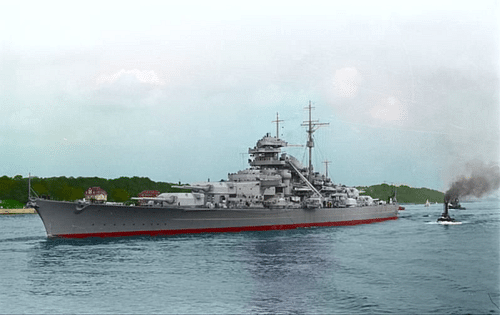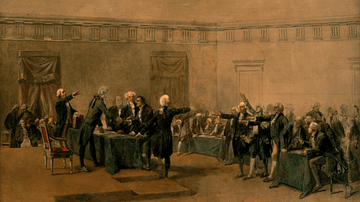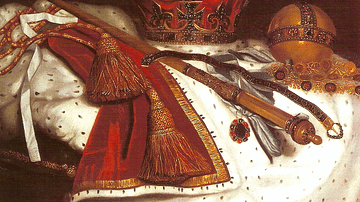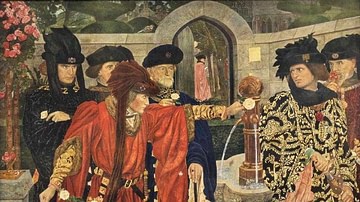The origins of the Second World War (1939-45) may be traced back to the harsh peace settlement of the First World War (1914-18) and the economic crisis of the 1930s, while more immediate causes were the aggressive invasions of their neighbours by Germany, Italy, and Japan. A weak and divided Europe, an isolationist USA, and an opportunistic USSR were all intent on peace, but the policy of appeasement only delivered what everyone most feared: another long and terrible world war.

The main causes of WWII were:
- The harsh Treaty of Versailles
- The economic crisis of the 1930s
- The rise of fascism
- Germany's rearmament
- The cult of Adolf Hitler
- The policy of appeasement by Western powers
- Treaties of mutual interest between Axis Powers
- Lack of treaties between the Allies
- The territorial expansion of Germany, Italy, and Japan
- The Nazi-Soviet Pact
- The invasion of Poland in September 1939
- The Japanese attack on the US naval base at Pearl Harbour
Treaty of Versailles
Germany was defeated in the First World War, and the victors established harsh terms to ensure that some of the costs of the war were recuperated and to prevent Germany from becoming a future threat. With European economies and populations greatly damaged by the war, the victors were in no mood to be lenient since Germany had almost won and its industry was still intact. Germany remained a dangerous state. However, Britain and France did not want a totally punitive settlement, as this might lead to lasting resentment and make Germany unable to become a valuable market for exports.
The peace terms were set out in the Treaty of Versailles, signed by all parties except the USSR on 28 June 1919. The Rhineland must be demilitarised to act as a buffer zone between Germany and France. All colonies and the Saar, a coal-rich area of western Germany, were removed from German authority. Poland was given the industrial area of Upper Silesia and a corridor to the sea, which included Danzig (Gdánsk) and cut off East Prussia from the rest of Germany. France regained the regions of Alsace and Lorraine. Germany had to pay war reparations to France and Belgium. Germany had limits on its armed forces and could not build tanks, aircraft, submarines, or battleships. Finally, Germany was to accept complete responsibility, that is the guilt, for starting the war. Many Germans viewed the peace terms as highly dishonourable.
The settlement established nine new countries in Eastern Europe, a recipe for instability since all of them disputed their borders, and many contained large minority groups who claimed to be part of another country. Germany, Italy, and Russia, once powerful again after the heavy costs of WWI, looked upon these fledgling states with imperialist envy.

In the 1920s, Germany signed two important treaties. The Locarno Treaty of 1925 guaranteed Germany's western borders but allowed some scope for change in the east. The 1928 Kellogg-Briand Pact was signed by 56 countries. All the major powers promised not to conduct foreign policy using military means. In 1929, Germany's reparations as stipulated by the Treaty of Versailles were reduced from £6.6 million to £2 million. In 1932, the reparations were cancelled altogether. This was all very promising, but through the 1930s, the complex web of European diplomacy began to quickly unravel in a climate of economic decline.
Economic Crisis
The Great Depression, sparked off by the Wall Street stock-market crash of 1929, resulted in a crisis in many economies through the 1930s. There was a collapse in world trade, prices, and employment. In Germany in 1923, there was hyperinflation, which made savings worthless, a blow many of the German middle class never forgot. The regular loans from the United States (the Dawes Plan), upon which the German economy depended, stopped. There was a hostile attitude amongst many states as international trade collapsed. The USA, the world's most important money lender, pursued an isolationist strategy. Britain and France looked only to their empires. Protectionism and trade tariffs became the norm.
Germany became determined to reach self-sufficiency and not rely on world trade partners, a policy that required the acquisition of natural resources through military occupation. Germany saw the route out of the financial mess as one of massive rearmament which would create jobs in factories and the armed forces. The policy involved not only stockpiling weapons but also creating an economy geared towards total war, where the armaments industry was given priority in terms of resources, energy, factories, and skilled workers.

Hitler & the Nazi Party
Nationalist fascist parties were doing well across Europe. From 1922, Italy was ruled by Benito Mussolini (l. 1883-1945), leader of the fascist party there. By 1939, Spain had a fascist ruler in General Franco (l. 1892-1975). In Germany, Adolf Hitler (l. 1889-1945) was the leader of the fascist National Socialist Party (Nazi Party), the largest party after the July and November elections of 1932. There were even fascist parties in democracies like Britain. Charismatic leaders were turning popular nationalist feelings into a much more sinister way of thinking: fascism. Fascist parties, although not exactly the same in different countries, did have some key goals in common. Fascist leaders wanted absolute power and to achieve this new order they emphasised "conformism, hostility to outsiders, routine violence, contempt for the weak, and extreme hatred of dissident opinions" (Dear, 274). Fascist parties initially gained popularity as opponents to communism, seen as a threat by many ever since the Russian Revolution of 1917. Indeed, in Western countries, a deep suspicion of communism prevented a powerful political and military alliance from being formed with the USSR, which might ultimately have avoided war.
Hitler promised the humiliation of Versailles would be revenged and that Germany would be made great again. Many Germans believed they had been betrayed by the high command of the army in WWI and were tired of the endless round of ineffective coalition governments since the war. Hitler, with no connections to the established elite, offered a new beginning, and most of all, he promised jobs and bread in a period when unemployment and poverty were at extremely high levels. The Nazi party promised a dynamic economy which would power German expansion, seen as a glorious endeavour, with the virtues of war championed. Nazism called for Lebensraum (living space) for the German people – new lands where they could prosper. Nazism identified its principal internal enemies as Jews, Slavs, Communists and trade unionists, all people who were holding Germany back from realising its full potential the Nazis claimed. Nazism called for an international struggle where Germans could achieve their destiny and prove themselves the master race. Such ideas, none of which were radically new, meant war was inevitable. The argument that totalitarian regimes require wars and liberal democracies require peace to prosper may be simplistic but has some validity. Hitler promised the new Third Reich would last for 1,000 years and, using propaganda, show, and brutal repression of alternative ideas, many believed him as he expertly tapped into long-held views in Germany and Austria. As F. McDonough states, "Hitler was the drummer of an old tune accompanied by modern instruments" (93).
In January 1933, the German President Paul von Hindenburg (l. 1847-1934), having run out of all other options, invited Hitler to become Chancellor. After systematically crushing any opposition, Hitler began to put his domestic policies into practice and establish a totalitarian regime, everything he had written in his book Mein Kampf (My Struggle) back in 1924. When Hindenburg died in August 1934, Hitler effectively merged the positions of President and Chancellor and declared himself Germany's leader or Führer. Hitler had become the state, and all that was now needed for him to achieve his impossible dream was a rearmed Germany.
Germany's Rearmament
Hitler was determined to rebuild the nation's armed forces. Rearmament rocketed despite the restrictions of Versailles, which Hitler formally repudiated in March 1935. The army was already four times bigger than permitted. Eventually, Western powers were obliged to take a damage-limitation approach. In June 1935, the Anglo-German Naval Agreement was signed, which capped the German navy's strength to 35% of the Royal Navy and allowed Hitler to build giant new ships like the battleship Bismarck.
In another instance of the cult of Adolf Hitler, all armed forces personnel had to swear allegiance to Hitler personally. Thanks to rearmament, Germany had achieved near-full employment by 1938. Hitler had fulfilled his promises to the German people. Germany's new war machine came at a cost. Rearming necessitated huge imports of raw materials, and these could not be bought for much longer as Germany's balance of payments went into tilt from 1939. Occupying territories where these resources could be found seemed a simple solution to the problem. Crucially, Germany had an arms advantage over its enemies, but this situation would not last long. For Hitler, the time to strike was now.
Appeasement
Allowing Germany to rearm was part of the policy of appeasement: giving reasonable concessions to avoid the total disaster of war. Appeasement, which was pursued by Britain, France, and the United States, did not mean peace at any price, but the problem with the policy was that it did give, step by step, aggressive powers the impression that their continued aggression might not necessarily lead to a wider war. To review these steps, we must look at global politics in the early 1930s.
The League of Nations (forerunner of today's United Nations) was established after WWI to ensure international disputes were settled and world peace was maintained. Although US President Woodrow Wilson (in office 1913-21) was instrumental in forming the League, crucially, the United States never joined it, seriously weakening the organisation. Germany joined in 1926 but left in 1933; Japan left the same year. The League proved to be utterly incapable of achieving its aims, as was shown most starkly by its failure to prevent Japan's invasion of Manchuria in September 1931 and Italy's invasion of Abyssinia (Ethiopia) in October 1935. Hitler no doubt watched these events and the League's total lack of a military response with particular interest as, with his own armed forces rejuvenated, he prepared to expand Germany's borders.
From 1933 to 1935, Hitler had pursued an ambiguous foreign policy, sometimes promising he had peaceful intentions. He caused confusion with such diplomatic conjuring tricks as a peace treaty with Poland in January 1934 and a statement later the same year that he had no intention of merging Austria into the Reich. Then, from 1935, his plans became ever clearer, even if some historians maintain the Führer actually had no plans at all but was merely seizing opportunities as his enemies presented them. Some historians claim Hitler was not entirely free to act as he would wish, due to constraints within the rather chaotic and factional Nazi party.
In March 1935, the Saar was reunified with Germany following a plebiscite. The same year, conscription was announced. In March 1936, Germany occupied the Rhineland. In October, Germany and Italy became formal allies with the Rome-Berlin Axis. In November 1936, Italy and Germany (and later Japan) signed the Anti-Comintern Pact, a treaty of mutual cooperation in empire-building and a united front against communism. In March 1938, Hitler achieved the Anschluss, the formal unification of Germany and Austria. Encouraged by the League of Nations' lack of a strong response, Hitler then occupied the Sudetenland, the industrial area of Czechoslovakia which shared a border with Germany, the excuse being a German minority there was being repressed. Again, the Western powers made no military reaction despite France and the USSR having signed a treaty of assistance with the Czechs. The Munich Agreement of September 1938 was signed between Germany, France, Italy, and Britain, which accepted Germany's new, expanded borders. The USSR was not invited, a lost and last opportunity to present a united front against fascism – perhaps here was the real price of pursuing a policy of appeasement to the exclusion of any other possible strategies. The British Prime Minister Neville Chamberlain (served 1937-40), fluttering before journalists a piece of paper Hitler had signed, confidently declared that he had achieved "peace with honour" (Dear, 597) and that we now had "peace in our time" (McDonough, 121). Chamberlain was nominated for that year's Nobel Peace Prize.

Why did Britain and France appease Hitler? Appeasement was an attractive policy to Western leaders since the horrors of the last war were still fresh in everyone's minds. France, in particular, was politically weak in this period, experiencing 16 coalition governments through the 1930s. Britain feared losing its empire if weakened by another great war. Public opinion was overwhelmingly against war and rearmament in Britain, France, and the United States. Further, it was by no means certain that Hitler would continue to expand Germany's borders; certainly, he had promised he had no additional ambitions beyond restoring Germany to its previous territories before WWI. Finally, appeasement, even if not actually believed to be a policy with any chance of success, did gain crucial time for Western powers to follow Germany's lead and rearm. In Britain and France, there were, too, strong lobbies which considered rearmament a waste of resources in economically turbulent times and pointed out that Germany was Britain's fifth largest customer for its exports. Hindsight has shown that appeasement was folly since Hitler was intent on occupying as much of Europe as he possibly could, and his track record of breaking treaties proved negotiation was pointless. Keeping the Czech heavy industry out of German hands was probably a better point to go to war over than the subsequent invasion of Poland, but Britain, France, and the USSR were simply not then equipped for war. Not until 1939 did these countries seriously begin to establish economies geared to war.
Invasion of Poland
In 1939, there was further significant activity by Germany and Italy in their quest to occupy more and more of Europe. In March 1939, Germany absorbed the rest of Czechoslovakia and Memel (part of Lithuania) into the Third Reich. Increasingly appalled by the Nazis' attacks on German Jews, Western powers now began to question if negotiating with such a regime could ever be justified on moral grounds. Appeasement was finally dead.
On 31 March, Britain and France promised to guarantee Poland's borders, and in April, this was extended to Romania. Turkey and Greece also began talks of mutual protection with Britain and France. It had finally dawned on leaders in Britain and France that the fascists were intent on territorial expansion at any cost. There was already a localised war going on, the Spanish Civil War of 1936-39, which directly involved German and Italian military hardware on the one side and Soviet aid on the other. In April, Italy occupied Albania. At the end of the same month, Hitler repudiated the Anglo-German Naval Agreement. In May 1939, Italy and Germany signed a military alliance, the ‘Pact of Steel'.
In August 1939, Germany agreed a non-aggression pact with the Soviet Union, the Molotov-Ribbentrop Pact (Nazi-Soviet Pact), named after the foreign ministers of each state. The Soviet leader Joseph Stalin (l. 1878-1953) was increasingly aware that Britain and France seemed perfectly willing to appease Hitler as long as he moved eastwards in his direction. The possibility of 'collective security' (Britain, France, and the USSR working together) was not realised because of a lack of trust between the parties. The Nazi-Soviet Pact, in contrast, allowed Stalin to grab eastern Poland and keep the USSR out of a war for a while, gaining precious time for rearmament. Perhaps, too, the possibility for Germany to wage war only in the West against Britain and France – Stalin's 'blank cheque' for Hitler – would sufficiently weaken all three so that they could no longer threaten the USSR.

Europe was a tinder box awaiting a single spark that would explode it into war. The spark came soon enough with Germany's invasion of Poland on 1 September 1939. The next day Chamberlain warned Hitler war would follow if Germany did not withdraw. Hitler ignored the ultimatum. On 3 September, Britain and France, in order to protect free and independent nations, declared war on Germany. Italy, waiting in the wings to see what might happen to its advantage, remained neutral for the time being. The world, too, awaited with bated breath to see what would happen next. The unexpected answer was nothing at all.
World War
The 'phoney war', when the Allies and Axis powers did not directly confront each other, lasted until April 1940 when Germany invaded Norway. In May, Germany invaded the Low Countries and France. Germany proved unstoppable, and by the end of June, France had fallen. In October, Italy invaded Greece. In 1941, Germany occupied Yugoslavia. Britain was left alone to fight for its survival until Hitler invaded the USSR in June 1941 (Operation Barbarossa).
The war became a global conflict when Japan attacked the US naval fleet at Pearl Harbour, Hawaii, on 7 December 1941. Japan had already invaded Eastern China over concern at the rise in Chinese nationalism and then occupied most of South East Asia in search of imperial glory and natural resources, especially oil, whose import was restricted by a US embargo. Japan perhaps hoped events in Europe would prevent any direct reaction against them, but the United States did finally join the conflict. Peace would not be achieved until the world had suffered four more long and bitter years of war.







